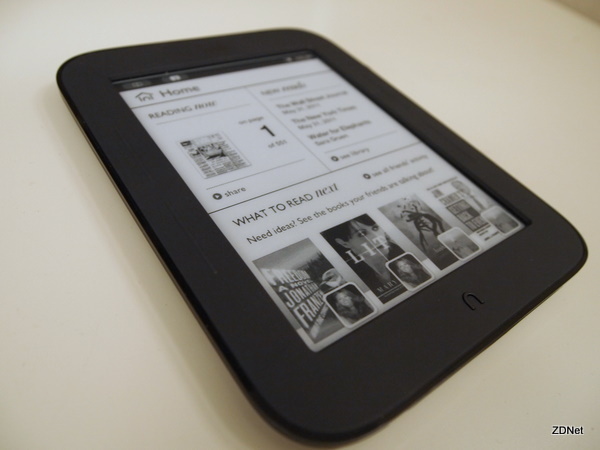Hands-on review: All-new B&N Nook e-book reader

Barnes & Noble has managed to ship its all-new Nook e-reader to stores and customers starting today, June 1st, ahead of its original June 10th launch date. We managed to get a unit, and here's a hands-on review.
Before getting started, I should clarify that I'm a fairly avid Nook user with copies of both the Nook Color and the Nook Wi-Fi First Edition. Sometimes I also read books (but mostly magazines) on my iPad. (You might then ask why I use so many devices for roughly the same purpose, but that's an entirely different story.)

Continuing on, I was quite excited to get my hands on the new Nook. Dubbed the "simple touch reader," it initially looks and feels incredibly smaller than the average e-book reader available now. In terms of how it feels in my hand, it is somewhere on par with the Sony Reader Pocket Edition. However, the all-new Nook (which really needs a new name after awhile because it won't be "all-new" for long) actually sports the exact same 6-inch eInk Pearl monochrome display as the Nook First Edition. Except this time the display supports touch gestures. Thus, naturally, the second generation of the Nook also drops the bottom touch screen.
There have been a few qualms in the tech media and by competitors since Barnes & Noble introduced the new Nook last week. First, Barnes & Noble CEO William Lynch declared that Amazon's Kindle 3 has 38 buttons, which is 37 more than the all new Nook. That one button Lynch was referring to was the power button, yet that assertion really isn't accurate. There are four buttons (two on each side) for page turning in case a user doesn't want to or maybe can't turn pages easily on the touch screen (this could be the case when standing on a subway train while reading). Even the included manual refers to these four ridges as buttons, so really, the Nook has five buttons (six if you count the "n" Nook button at the bottom of the device too). Still, that's far fewer than the previous edition of the black-and-white Nook and the Kindle.
The second upset that gained the most notoriety was Barnes & Noble's announcement that this device has the longest lasting battery life than any other e-book reader on the market at a staggeringly long life of two months on a single charge. That point is based on the idea that a user only reads for 30 minutes per day. There haven't been enough studies to accurately determine just which is the average amount of time a reader spends perusing books and magazines on an electronic device, but if you're using such a product while commuting on a train or bus, I'm willing to bet that it's a minimum of 30 minutes each way. Naturally, Amazon quickly tried to refute these claims and boast about the Kindle's battery life, but the all-new Nook still outlasts the Kindle 3 at a rate of 150 hours to 56 hours respectively.
Once we get past those points of controversy, this review becomes much simpler. Some of the bigger improvements with this version of the Nook include the interface and the fact that there is 80% less screen flashing than on any other e-book reader. A user can go at least six pages without seeing that black flash between page turns, which actually becomes a nuisance once you get used to the fact that it's gone most of the time. Additionally, users can speed up page turning to a rapid pace by holding down the side buttons. There's almost no flash at all during this movement.
As for the interface, the easiest way to explain it is that it's basically a dumbed-down, grayscale version of the Nook Color's UI. Users can create shelves, navigate and toggle between menus by the pop-up bars at the bottom of the page and shop directly from the device with a much cleaner layout. However, don't expect to see any games or audio players (there's no headphone jack or speaker). That microSD card slot is really only useful for more book and periodical storage as there's 240MB of on-board storage space. Nevertheless, at only 7.5 ounces heavy and being 15% thinner than the original Nook, it hardly gets more portable than this.
To sum up simply: This is a stripped, bare basics version of the Nook that would be ideal for students and anyone else on a budget.
To check out a feature-by-feature look of the newest Nook, check out our photo gallery with details.
Related coverage on ZDNet:
- Barnes & Noble intros pocket-sized Nook with two-month battery life
- Why Kindle has already won the ebook war
- Beyond simple rooting: Turning the Nook Color into a complete tablet
- Gallery: Turning the Nook Color into a complete tablet
- John Malone's Liberty Media bid for Barnes & Noble was a smart move